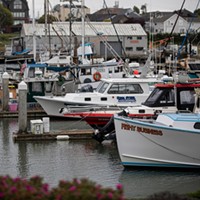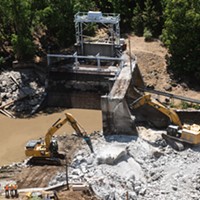Sunday, April 17, 2016
TL;DR: Five Things You Need to Know About This Week's Cover Story
Posted By Thadeus Greenson @ThadeusGreenson on Sun, Apr 17, 2016 at 11:10 AM
Busy week? We get it, and we're not judging. Here are some highlights from “Until the Sun Sets” to get you caught up.
On April 6, federal, state and tribal officials descended on Yurok Tribal land to ink a new pact to remove four hydroelectric dams that have choked the Klamath River for decades. It was a historic day, but beyond the pomp and circumstance, what does the deal really mean for the river and the new path forward toward dam removal?
1) The path forward is uncertain. We’ve been here before. In fact, six years ago, many of the same stakeholders trumpeted the signing of another agreement that seemed to imply the dams’ days were numbered, with then California Gov. Arnold Schwarzenegger crowing, “By finalizing that agreement, we can say ‘hasta la vista’ to the dams.” While this agreement doesn’t require the congressional approval that doomed the last one, an arduous road lies ahead. The agreement needs to get the OK of the Federal Energy Commission (FERC), which will ultimately decide whether the dams should come out. To make that determination, FERC will also require a host of permits — from state, federal and local agencies and governments, including from a couple of counties that have voiced strong opposition to dam removal. There’s also an election looming, and some fear a new president could bring a new cabinet with new priorities that could result in the back-burnering of what would be the largest dam removal project in the nation’s history. Some also fear that Congress — a faction of which is ideologically opposed to taking out dams — may try to reinsert itself into the process.
2) The dams’ owners support removal. PacifiCorp, the Berkshire Hathaway subsidiary that owns the four Klamath dams, is on board with the agreements. That’s largely because taking out the dams is good for the company, its ratepayers and its shareholders. With an application pending before FERC to relicense the four dams, PacifiCorp realizes that new licenses would come with new environmental requirements that weren’t in place when the dams were built and licensed decades ago. These would include the installation of fish ladders at the four dams, and other things to improve water quality and increase fish passage. Studies indicate these alterations would be expensive and ultimately reduce the power generating ability of the dams by about 20 percent. Additionally, under the deal, it’s the company’s ratepayers and the state of California, through a water bond, that will pay the $450 million needed to remove the dams.
3) The plan is to remove all the dams in a single year, 2020. The U.S. Geological Survey’s Klamath project manager, Dennis Lynch, said models indicate that removing all the dams at once will actually lessen the overall impact on the river ecosystem. So, the plan is to draw down all the reservoirs behind the dam during the high flows of winter and then to physically remove the dams in spring and summer.
4) There will be short-term negative impacts on fish. There are some 15 million cubic yards of sediment trapped behind the dams. While the sediment has tested clean and doesn’t pose any toxic threats, about 85 percent of it is fine silts and clays that will cloud the river for several months until it flows out to the ocean. This may prove lethal to some fish. But Lynch said the plan is to time the reservoir draw-downs and the release of all that silt-filled sediment for when sensitive species — like coho — are in tributaries or out at sea to help mitigate the impacts.
5) But, in the long run, science says this will be really good for fish. Lynch said his team’s studies indicate the four dams are responsible for much of the Klamath River’s water quality problems, most notably the warming of the river that fosters toxic algal blooms. Removing the dams won’t increase downriver flows, Lynch said, but it will cause the river to flow colder and cleaner. And taking out the dams will instantly open up hundreds of miles of steelhead, coho and chinook habitat. “In the long term, there’s no information out there that says this is the wrong idea,” Lynch said.
On April 6, federal, state and tribal officials descended on Yurok Tribal land to ink a new pact to remove four hydroelectric dams that have choked the Klamath River for decades. It was a historic day, but beyond the pomp and circumstance, what does the deal really mean for the river and the new path forward toward dam removal?
1) The path forward is uncertain. We’ve been here before. In fact, six years ago, many of the same stakeholders trumpeted the signing of another agreement that seemed to imply the dams’ days were numbered, with then California Gov. Arnold Schwarzenegger crowing, “By finalizing that agreement, we can say ‘hasta la vista’ to the dams.” While this agreement doesn’t require the congressional approval that doomed the last one, an arduous road lies ahead. The agreement needs to get the OK of the Federal Energy Commission (FERC), which will ultimately decide whether the dams should come out. To make that determination, FERC will also require a host of permits — from state, federal and local agencies and governments, including from a couple of counties that have voiced strong opposition to dam removal. There’s also an election looming, and some fear a new president could bring a new cabinet with new priorities that could result in the back-burnering of what would be the largest dam removal project in the nation’s history. Some also fear that Congress — a faction of which is ideologically opposed to taking out dams — may try to reinsert itself into the process.
2) The dams’ owners support removal. PacifiCorp, the Berkshire Hathaway subsidiary that owns the four Klamath dams, is on board with the agreements. That’s largely because taking out the dams is good for the company, its ratepayers and its shareholders. With an application pending before FERC to relicense the four dams, PacifiCorp realizes that new licenses would come with new environmental requirements that weren’t in place when the dams were built and licensed decades ago. These would include the installation of fish ladders at the four dams, and other things to improve water quality and increase fish passage. Studies indicate these alterations would be expensive and ultimately reduce the power generating ability of the dams by about 20 percent. Additionally, under the deal, it’s the company’s ratepayers and the state of California, through a water bond, that will pay the $450 million needed to remove the dams.
3) The plan is to remove all the dams in a single year, 2020. The U.S. Geological Survey’s Klamath project manager, Dennis Lynch, said models indicate that removing all the dams at once will actually lessen the overall impact on the river ecosystem. So, the plan is to draw down all the reservoirs behind the dam during the high flows of winter and then to physically remove the dams in spring and summer.
4) There will be short-term negative impacts on fish. There are some 15 million cubic yards of sediment trapped behind the dams. While the sediment has tested clean and doesn’t pose any toxic threats, about 85 percent of it is fine silts and clays that will cloud the river for several months until it flows out to the ocean. This may prove lethal to some fish. But Lynch said the plan is to time the reservoir draw-downs and the release of all that silt-filled sediment for when sensitive species — like coho — are in tributaries or out at sea to help mitigate the impacts.
5) But, in the long run, science says this will be really good for fish. Lynch said his team’s studies indicate the four dams are responsible for much of the Klamath River’s water quality problems, most notably the warming of the river that fosters toxic algal blooms. Removing the dams won’t increase downriver flows, Lynch said, but it will cause the river to flow colder and cleaner. And taking out the dams will instantly open up hundreds of miles of steelhead, coho and chinook habitat. “In the long term, there’s no information out there that says this is the wrong idea,” Lynch said.
Speaking of...
Comments
Showing 1-1 of 1
Readers also liked…
more from the author
-
'Inadvertent Disclosure'
Eureka City Schools emails shed light on Jacobs property swap
- Jul 25, 2024
-
Jackson's Retreat
The contract clause that allowed Cal Poly Humboldt's embattled president to step down into a high-paid instructional position
- Jul 25, 2024
-
'Profound Concern'
Alleged victim distressed by DA's handling of hate speech, antisemitic threats case
- Jul 25, 2024
- More »



































